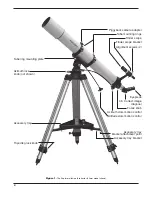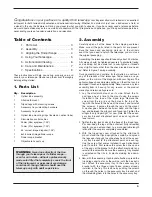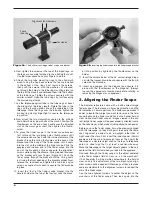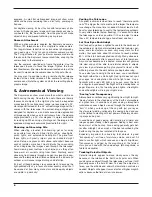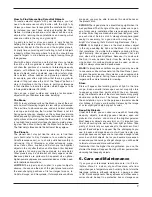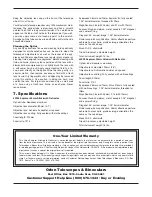
6
eyepiece. A small but well-resolved image will show more
detail and be more rewarding than a dim, fuzzy, over-magni-
fied one.
For daytime viewing, it’s best to stick with low powers of 50x
or less. At higher powers, images will lose sharpness due to
sun-heated air; the “heat waves” from the ground will make
objects blurry and prevent obtaining a crisp focus.
Camera attachment
With an optional camera adapter, the Explorers become a
910mm f/10 telephoto lens for a single-lens reflex camera.
For long-distance terrestrial or astronomical photography,
you need only a T-ring for your particular camera model.
The T-ring attaches to your particular camera model and
threads onto the Explorer’s focuser drawtube, coupling the
camera body to the telescope.
Use the camera’s viewfinder to frame the picture. Use the
telescope’s focuser to focus the image. Tighten the focus
lock thumbscrew (the large thumbscrew located on top of the
focuser) to make sure the camera does not slip out of focus.
You may want to consider using a remote shutter release
instead of the shutter release on the camera. Touching the
camera can vibrate the system and blur the resulting photo-
graphic image.
5. astronomical Viewing
The Explorers can show much more than what is visible on
Earth during the day. Once the Sun sets, there are literally
thousands of objects in the night sky that can be inspected
more closely. For astronomical usage, we recommend a 90°
star diagonal instead of the 45° correct-image diagonal that
comes with the telescope. The correct-image diagonal is
designed for daytime use, and will cause some degradation
of image quality when used for astronomy. Also, the viewing
angle provided by a 90° star diagonal is more comfortable
for looking up. When using a star diagonal, the image in the
eyepiece will appear backwards (inverted left-to-right).
Choosing an observing Site
When selecting a location for observing, get as far away
as possible from direct artificial light such as streetlights,
porch lights, and automobile headlights. The glare from
these lights will greatly impair your dark-adapted night
vision. Set up on a grass or dirt surface, not asphalt, because
asphalt radiates more heat. Heat disturbs the surrounding
air and degrades the images seen through the telescope.
Avoid viewing over rooftops and chimneys, as they often
have warm air currents rising from them. Similarly, avoid
observing from indoors through an open (or closed) window,
because the temperature difference between the indoor and
outdoor air will cause image blurring and distortion.
It’s best, although perhaps less convenient, to escape the
light-polluted city sky in favor of darker country skies. You’ll
be amazed at how many more stars and deep-sky objects
are visible in a dark sky!
Cooling the telescope
All optical instruments need time to reach “thermal equilib-
rium.” The bigger the instrument and the larger the tempera-
ture change, the more time is needed. Allow at least a half-
hour for your telescope to cool to the temperature outdoors.
In very cold climates (below freezing), it is essential to store
the telescope as cold as possible. If it has to adjust to more
than a 40° temperature change, allow at least one hour.
let Your Eyes Dark-adapt
Don’t expect to go from a lighted house into the darkness of
the outdoors at night and immediately see faint nebulas, gal-
axies, and star clusters—or even very many stars, for that
matter. Your eyes take about 30 minutes to reach perhaps
80% of their full dark-adapted sensitivity. Many observers
notice improvements after several hours of total darkness.
As your eyes become dark-adapted, more stars will glimmer
into view and you’ll be able to see fainter details in objects
you view in your telescope. So give yourself at least a little
while to get used to the dark before you begin observing.
To see what you’re doing in the darkness, use a red-filtered
flashlight rather than a white light. Red light does not spoil
your eyes’ dark adaptation like white light does. Use a
flashlight with a red LED light, or you can cover the front
of a regular incandescent flashlight with red cellophane or
paper. Beware, too, that nearby porch lights, streetlights,
and car headlights will ruin your night vision.
“Seeing” and transparency
Atmospheric conditions vary significantly from night to night.
“Seeing” refers to the steadiness of the Earth’s atmosphere
at a given time. In conditions of poor seeing, atmospheric
turbulence causes objects viewed through the telescope to
“boil.” If, when you look up at the sky with just your eyes,
the stars are twinkling noticeably, the seeing is bad and you
will be limited to viewing with low powers. Planetary observ-
ing may also be poor.
In conditions of good seeing, star twinkling is minimal and
images appear steady in the eyepiece. Seeing is best over-
head, worst at the horizon. Also, seeing generally gets bet-
ter after midnight, when much of the heat absorbed by the
Earth during the day has radiated off into space.
Especially important for observing faint objects is good
“transparency”—air free of moisture, smoke, and dust. All
tend to scatter light, which reduces an object’s brightness.
Transparency is judged by the magnitude of the faintest
stars you can see with the unaided eye (6th magnitude or
fainter is desirable).
tracking Celestial objects
Celestial objects appear to move slowly across the sky
because of the rotation of the Earth on its polar axis. When
you observe an object through the telescope, you’ll see it drift
gradually across the field of view. To keep the object cen-
tered, use the altitude and azimuth slow-motion controls as
needed. Objects will appear to move faster at higher magnifi-
cations because the field of view is narrower.


